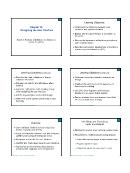 Bài giảng Systems Analysis and Design in a Changing World - Chapter 14: Designing the User Interface
Bài giảng Systems Analysis and Design in a Changing World - Chapter 14: Designing the User InterfaceSummary (continued) User interface is described with metaphors (desktop, document, dialog) Interface design guidelines and standards are available from many sources Dialog design starts with events, adds dialogs for integrity controls, user preferences, help, menus OO approach provides UML models to document dialog designs, includin...
 7 trang | Chia sẻ: vutrong32 | Ngày: 19/10/2018 | Lượt xem: 1132 | Lượt tải: 0
7 trang | Chia sẻ: vutrong32 | Ngày: 19/10/2018 | Lượt xem: 1132 | Lượt tải: 0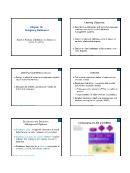 Bài giảng Systems Analysis and Design in a Changing World - Chapter 13: Designing Databases
Bài giảng Systems Analysis and Design in a Changing World - Chapter 13: Designing DatabasesSummary (continued) Object database stores data as collection of related objects and is developed from class diagram Objects can also be stored within RDBMS RDBMS cannot store methods RDBMS cannot directly represent inheritance Medium and larger information systems typically use multiple databases or database servers in various ge...
 10 trang | Chia sẻ: vutrong32 | Ngày: 19/10/2018 | Lượt xem: 1597 | Lượt tải: 0
10 trang | Chia sẻ: vutrong32 | Ngày: 19/10/2018 | Lượt xem: 1597 | Lượt tải: 0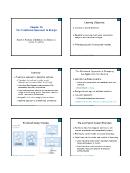 Bài giảng Systems Analysis and Design in a Changing World - Chapter 10: The Traditional Approach to Design
Bài giảng Systems Analysis and Design in a Changing World - Chapter 10: The Traditional Approach to DesignSummary (continued) Structure charts may be based on three-layer architecture Modules will be clearly identified by layer Structure chart may be decomposed if layers execute on multiple systems Structured design may also include: System flowcharts to show data movement Module pseudocode to describe internal logic of structure ch...
 6 trang | Chia sẻ: vutrong32 | Ngày: 19/10/2018 | Lượt xem: 1431 | Lượt tải: 0
6 trang | Chia sẻ: vutrong32 | Ngày: 19/10/2018 | Lượt xem: 1431 | Lượt tải: 0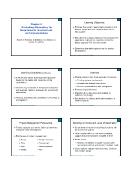 Bài giảng Systems Analysis and Design in a Changing World - Chapter 8: Evaluating Alternatives for Requirements, Environment, and Implementation
Bài giảng Systems Analysis and Design in a Changing World - Chapter 8: Evaluating Alternatives for Requirements, Environment, and ImplementationSummary (continued) Determine what alternatives are possible for developing solution Implementation alternatives include: Building system in-house Buying packaged or turnkey solution Contracting with developer to build it (outsource) Develop recommendations and present to management to make funding decisions
 6 trang | Chia sẻ: vutrong32 | Ngày: 19/10/2018 | Lượt xem: 1193 | Lượt tải: 0
6 trang | Chia sẻ: vutrong32 | Ngày: 19/10/2018 | Lượt xem: 1193 | Lượt tải: 0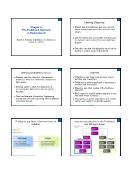 Bài giảng Systems Analysis and Design in a Changing World - Chapter 6: The Traditional Approach to Requirements
Bài giảng Systems Analysis and Design in a Changing World - Chapter 6: The Traditional Approach to RequirementsSummary (continued) Models from IE may supplement DFDs Process decomposition diagram (how processes on multiple DFD levels are related) Process dependency diagram (emphasizes interaction with stored entities) Location diagram (geographic where system used) Activity-location matrix (which processes are implemented at which location...
 9 trang | Chia sẻ: vutrong32 | Ngày: 19/10/2018 | Lượt xem: 1517 | Lượt tải: 0
9 trang | Chia sẻ: vutrong32 | Ngày: 19/10/2018 | Lượt xem: 1517 | Lượt tải: 0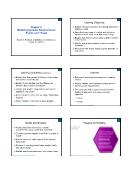 Bài giảng Systems Analysis and Design in a Changing World - Chapter 5: Modeling Systems Requirements: Events and Things
Bài giảng Systems Analysis and Design in a Changing World - Chapter 5: Modeling Systems Requirements: Events and ThingsSummary (continued) Things are what user deals with and system remembers, such as customer placing an order Traditional approach uses entity-relationship diagrams (ERD) for data entities, attributes of data entities, and relationships between entities Things are shown as data entities Object-oriented approach uses class diagrams for...
 9 trang | Chia sẻ: vutrong32 | Ngày: 19/10/2018 | Lượt xem: 1315 | Lượt tải: 0
9 trang | Chia sẻ: vutrong32 | Ngày: 19/10/2018 | Lượt xem: 1315 | Lượt tải: 0 Chapter 9 Assertions, Views and Programming Techniques
Chapter 9 Assertions, Views and Programming TechniquesControl structure Example: SELECT ProductID, Quantity, UnitPrice, [discount%]= CASE WHEN Quantity <=5 THEN 0.05 WHEN Quantity BETWEEN 6 and 10 THEN 0.07 WHEN Quantity BETWEEN 11 and 20 THEN 0.09 ELSE 0.1 END FROM [Order Details] ORDER BY Quantity, ProductId
 40 trang | Chia sẻ: vutrong32 | Ngày: 19/10/2018 | Lượt xem: 1413 | Lượt tải: 0
40 trang | Chia sẻ: vutrong32 | Ngày: 19/10/2018 | Lượt xem: 1413 | Lượt tải: 0 Chapter 8 SQL: Schema Definition, Basic Constraints, and Queries
Chapter 8 SQL: Schema Definition, Basic Constraints, and QueriesInsert, delete, and update The UPDATE Command: to modify attribute values of one or more selected tuples. a WHERE clause in the UPDATE command selects the tuples to be modified from a single relation. However, updating a primary key value may propagate to the foreign key values of tuples in other relations if such a referential triggere...
 58 trang | Chia sẻ: vutrong32 | Ngày: 19/10/2018 | Lượt xem: 1467 | Lượt tải: 2
58 trang | Chia sẻ: vutrong32 | Ngày: 19/10/2018 | Lượt xem: 1467 | Lượt tải: 2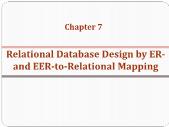 Chapter 7 Relational Database Design by ERand EER-To-Relational Mapping
Chapter 7 Relational Database Design by ERand EER-To-Relational MappingMapping EER Model Constructs to Relations Step 9: Mapping of Union Types (Categories). For mapping a category whose defining superclass have different keys, it is customary to specify a new key attribute, called a surrogate key, when creating a relation to correspond to the category. In the example below we can create a relation OWNER t...
 39 trang | Chia sẻ: vutrong32 | Ngày: 19/10/2018 | Lượt xem: 1556 | Lượt tải: 0
39 trang | Chia sẻ: vutrong32 | Ngày: 19/10/2018 | Lượt xem: 1556 | Lượt tải: 0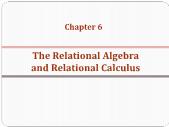 Chapter 6 The Relational Algebra and Relational Calculus
Chapter 6 The Relational Algebra and Relational CalculusTuple Relational Calculus The tuple relational calculus is based on specifying a number of tuple variables. Each tuple variable usually ranges over a particular database relation, meaning that the variable may take as its value any individual tuple from that relation. A simple tuple relational calculus query is of the form {t | COND(t)} w...
 51 trang | Chia sẻ: vutrong32 | Ngày: 19/10/2018 | Lượt xem: 1424 | Lượt tải: 0
51 trang | Chia sẻ: vutrong32 | Ngày: 19/10/2018 | Lượt xem: 1424 | Lượt tải: 0


